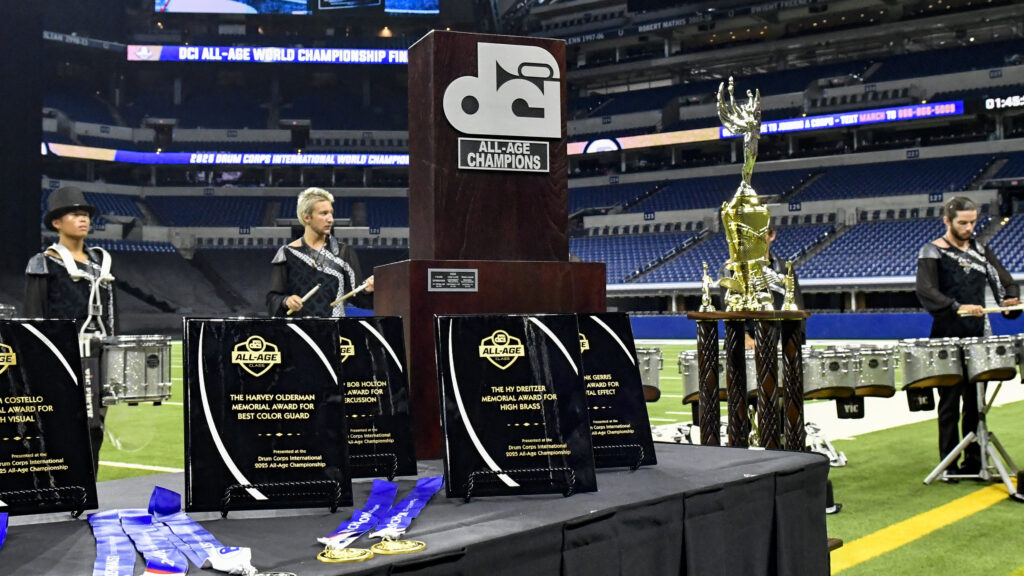The 2001 Drum Corps International World Championship was held at Orchard Park’s Ralph Wilson Stadium, located outside Buffalo, New York. It marked the third time DCI corps went to the stadium for their final week of the season.
The Cavaliers took the title for the second year in a row with its “Four Corners” production, besting Blue Devils’ “Awayday Blue,” about a holiday escape for fun and relaxation, and Cadets’ “Juxtaperformance,” a show purposely composed without a theme.
2001 was the first year that a large percentage of competing corps switched from G-keyed bugles to B-flat horns. While 2000 was the first year those new instruments were allowed, only two corps, Cadets and Blue Devils, had utilized them.

Taking eighth place, Canton, Ohio’s Bluecoats performed “Latin Sketches,” based entirely on two works by American pop-rock-jazz-symphonic composer Michael Daugherty. Just a year earlier, the composer had been the focus of the music for Cavaliers’ World Championship-winning “Niagara Falls.”
Critics have stated that the music of Daugherty “positively pulsates with kinetic energy” and “may just provide the link to pop culture that classical music so desperately needs.” While some composers strive to appease the academic sector of contemporary music, Daugherty is not at all shy about embracing the sounds of American culture, having played keyboards in rock and funk bands, and jazz piano in lounges and nightclubs throughout his career.
The Bluecoats show explored two of Daugherty’s works that explored his fascination with Afro-Cuban jazz, in particular two traditional Latin dances that ooze with passion, the rhumba and the tango.

Prior to the start of the show, DCI Hall of Fame public address announcer Brandt Crocker introduced the drum major. Normally that would not be news, but this drum major was David Glasgow, who went on to become the organization’s Executive Director, leading the corps to its very first World Championship title in 2016.
After a brief fanfare, a walking bass line in the tubas opened “Candelabra Rhumba,” with Cuban percussion instruments throwing a vivacious rhythm across the field.
The work, from 1996, is the fourth movement of “Le Tombeau de Liberace,” written in 1996 for piano and orchestra and recorded on Daugherty’s album, “American Icons.” It is often said that Liberace is one of the most intriguing American musical icons. Often attired in outrageous fur coats, donning flamboyant jewelry, and playing under his trademark candelabra, the popular Vegas show pianist blurred the line between gaudy and colorful, ridiculous and uplifting.

The term “rhumba” (also spelled “rumba”) originally meant “party” in the Cuban vocabulary. As if celebrating a party, color guard members with sabers were prominently featured up front during an extended segment that lasted well over three minutes. Having them up front for so long allowed the audience to soak in their irrepressible smiles.
A rhumba can be slow or quick, and this one covered a variety of moods of the different rhumbas that make up the idiom, from the slow middle section to an ending that was quite forceful and driving.
The last two-thirds of the production was devoted to “Red Cape Tango,” the fifth and final movement from Daugherty’s “Metropolis Symphony.” The composer was inspired by decades of Superman comics and was commissioned by the Albany Symphony Orchestra in 1993 to create this movement. Prominently featured in the tango is the medieval Latin “Dies Irae” chant for the dead, representing Superman’s fight to the death with his nemesis, Doomsday.

Atop the sensual tango pulse introduced by the timpani in the front ensemble percussion section, chimes played the “Dies Irae” (think the opening music to the movie “The Shining,” for example), conveying the seriousness of the nature of this piece in comparison to the opener.
One-by-one, three triangular tarps were spread on the field in solid colors of red, orange, and purple. Color guard members seductively performed authentic tango steps atop and surrounding the tarps.
The first tarp laid on the ground was the red one, appropriate since Daugherty wrote in his program notes that the alternating of the orchestra “between legato and staccato sections” suggested “a musical bullfight.”

A faster section also based on “Dies Irae” followed, alternating chords accented by the brass section. This led into a statement of the melody by the brass over a slower rendition of the melody played in hemiola (three against two) by the mallet percussionists.
After a standstill company front that dissolved and reformed twice, the finale of the piece turned into a frenzied push to the finish, the intensity of the final statement of “Dies Irae” only topped by that of the audience yelling “Blooo” upon its completion.
2001 DCI World Championship Awards Ceremony

Michael Boo was a member of the Cavaliers from 1975-1977. He wrote about the drum corps activity for more than 35 years while serving as a staff writer for various Drum Corps International projects. During his lifetime Boo wrote for numerous other publications including an honors-winning book on the history of figure skating. He also was an accomplished composer. Boo passed away in 2020 and was inducted into the DCI Hall of Fame posthumously in 2021.





